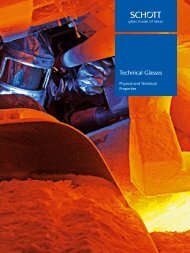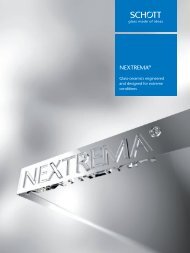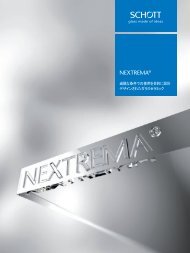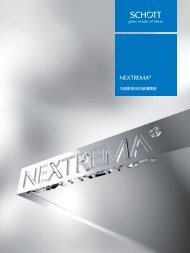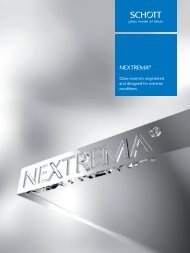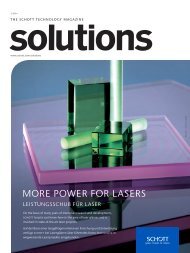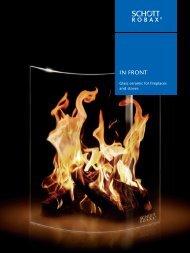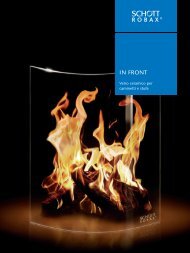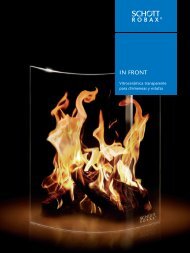Technology Magazine "SCHOTT solutions" - Edition 2/2013 - Technologie Magazin "SCHOTT solutions"
A variety of SCHOTT innovations The latest issue of our technology magazine “solutions” discusses innovations our SCHOTT experts are developing, how they provide support for our customers as partners and how they are addressing tomorrow’s challenges today. Our broad range of products and materials opens up a wide variety of different topics ranging from the universe all the way to the nano cosmos. We wish you enjoyable reading! Spannende Stories über SCHOTT Innovationen Die neuste Ausgabe des Technologiemagazins „solutions“ verrät, was SCHOTT Experten entwickeln, wie sie Anwendern kompetenter Partner sind und die Herausforderungen von morgen schon heute anpacken. Unsere breite Produkt- und Materialpalette erschließt dabei ein weites Feld: vom Weltall bis in den Nanokosmos. Viel Spaß beim Lesen!
A variety of SCHOTT innovations
The latest issue of our technology magazine “solutions” discusses innovations our SCHOTT experts are developing, how they provide support for our customers as partners and how they are addressing tomorrow’s challenges today. Our broad range of products and materials opens up a wide variety of different topics ranging from the universe all the way to the nano cosmos. We wish you enjoyable reading!
Spannende Stories über SCHOTT Innovationen
Die neuste Ausgabe des Technologiemagazins „solutions“ verrät, was SCHOTT Experten entwickeln, wie sie Anwendern kompetenter Partner sind und die Herausforderungen von morgen schon heute anpacken. Unsere breite Produkt- und Materialpalette erschließt dabei ein weites Feld: vom Weltall bis in den Nanokosmos. Viel Spaß beim Lesen!
Create successful ePaper yourself
Turn your PDF publications into a flip-book with our unique Google optimized e-Paper software.
thography devices for manufacturing thousands or even millions<br />
of circuits for controlling the colors that LCD monitors display, as<br />
well as in chip manufacturing, where the structural sizes will continue<br />
to become smaller and shrink to just a few nanometers in the<br />
years to come. Essentially, ZERODUR® glass-ceramic components<br />
are found in applications that require the highest precision, reliability<br />
and operational security of the components used in order<br />
to ensure that these complex processes run smoothly. “Thanks to<br />
this optimized calculation model and reliable data on strength, we<br />
have been able to prove that ZERODUR® glass-ceramic is even<br />
stronger and more stable under severe conditions than we had first<br />
assumed. This opens up new prospects for designers in building<br />
their instruments and devices,” explains Dr. Peter Hartmann, who<br />
was awarded the <strong>SCHOTT</strong> R&D Prize for his model.<br />
“This work documents a high degree of scientific and technical<br />
professionalism and demonstrates the outstanding material and<br />
technological expertise <strong>SCHOTT</strong> has,” explained <strong>SCHOTT</strong> Board<br />
Member Dr. Hans-Joachim Konz at the award ceremony. “Furthermore,<br />
this work underscores our goal of offering benefits to our<br />
customers through our profound understanding of materials. This<br />
is thus an example of the successful link between science on the<br />
one hand and technical marketing on the other,” he added. <<br />
peter.hartmann@schott.com<br />
Bildschirmen. Oder in der Chipproduktion, bei der die Strukturgrößen<br />
in den nächsten Jahren auf wenige Nanometer schrumpfen.<br />
Kurz: Anwendungen, bei denen höchste Präzision, Zuverlässigkeit<br />
und Betriebssicherheit der Komponenten von größter Bedeutung<br />
für das reibungslose Funktionieren komplexer Prozesse sind. „Mit<br />
dem optimierten Berechnungsmodell und belastbaren Daten zur<br />
Festigkeit konnte nachgewiesen werden, dass ZERODUR® Glaskeramik<br />
unter verschärften Umständen fester und stabiler ist als<br />
bisher angenommen. Das eröffnet Anwendern neue Perspektiven<br />
bei der Konstruktion ihrer Instrumente und Geräte“, erklärt<br />
Dr. Peter Hartmann, der für sein Modell mit dem <strong>SCHOTT</strong><br />
F&E-Preis ausgezeichnet wurde.<br />
„Die Arbeit dokumentiert einen hohen Grad an wissenschaftlich-technischer<br />
Professionalität und demonstriert die hervorragende<br />
Material- und <strong>Technologie</strong>kompetenz bei <strong>SCHOTT</strong>“,<br />
erklärt Vorstandsmitglied Dr. Hans-Joachim Konz bei der Preisverleihung.<br />
„Zudem unterstreicht die Arbeit unseren Anspruch,<br />
Kundennutzen durch exzellentes Materialverständnis zu schaffen.<br />
Sie ist Beispiel für die gelungene Verknüpfung zwischen Wissenschaft<br />
einerseits und technischem Marketing andererseits.“ <<br />
peter.hartmann@schott.com<br />
EXTREMELY LOW THERMAL EXPANSION<br />
ZERODUR ® glass-ceramic, which consists mainly of the ingredients<br />
lithium oxide, aluminum oxide and silicon oxide (LAS), is melted as<br />
glass and then transformed into a glass-ceramic through the process<br />
of ceramization. Here, the glass is first heated to a temperature that<br />
initiates the cultivation of seed crystals, which are then grown in a<br />
second step. After it has cooled, it leaves behind a material that<br />
consists of nanometer sized crystallites that are embedded in a residual<br />
glass phase. By cleverly selecting the type of crystal and having<br />
precise knowledge of how seeds form and crystals grow, the properties<br />
of these glass-ceramics can be precisely controlled. The negative<br />
thermal expansion of the LAS crystals compensates for the positive<br />
thermal expansion of the residual glass and makes ZERODUR ® from<br />
<strong>SCHOTT</strong> an extremely homogeneous, zero-expansion material. Here,<br />
the “zero” is meant in terms of physical/technical properties, and is<br />
expressed physically in a range of error. For scientists and engineers,<br />
the narrowest tolerance degree available for ZERODUR ® is ± . x<br />
- /K. This equates to a CTE* (Coefficient of Thermal Expansion) that<br />
is times lower than that of conventional glasses and roughly<br />
times lower than metals. If necessary, ZERODUR ®' s expansion<br />
behavior can be adjusted to suit the actual temperature progression<br />
in a customers application. <<br />
*CTE (° C; ° C) describes the median coefficient of linear thermal expansion<br />
(CTE) within the temperature range ° C to ° C.<br />
EXTREM NIEDRIGER AUSDEHNUNGSKOEFFIZIENT<br />
ZERODUR ® Glaskeramik mit den Hauptbestandteilen Lithiumoxid,<br />
Aluminiumoxid und Siliciumoxid wird als Glas geschmolzen und<br />
durch die sogenannte Keramisierung in die Glaskeramik überführt.<br />
Dazu wird das Glas in einem ersten Schritt auf eine Temperatur erwärmt,<br />
in der gezielt Kristallkeime gezüchtet und in einem zweiten<br />
Schritt zum Wachsen gebracht werden. Nach Abkühlung ist ein Material<br />
aus nanometergroßen Kristalliten entstanden, die in einer Restglasphase<br />
eingebettet sind. Durch geschickte Wahl des Kristalltyps<br />
und die genaue Kenntnis von Keimbildung und Kristallwachstum ist<br />
es möglich, die Eigenschaften der Glaskeramiken gezielt einzustellen.<br />
Die negative thermische Ausdehnung der LAS-Kristalle kompensiert<br />
die positive thermische Ausdehnung des Restglases und macht<br />
ZERODUR ® von <strong>SCHOTT</strong> zu einem äußerst homogenen Nullausdehnungsmaterial<br />
– die Null ist hier physikalisch-technisch gemeint und<br />
daher als solche nicht mathematisch exakt, sondern physikalisch mit<br />
einer Fehlerbandbreite angegeben. Für Experten: Der engste verfügbare<br />
Toleranzgrad für ZERODUR ® mit ± , x - /K entspricht einem<br />
-mal niedrigeren thermischen Ausdehnungskoeffizienten CTE*<br />
(Coefficient of Thermal Expansion) bei konventionellen Gläsern und<br />
einem etwa -mal geringeren bei Metallen. Bei Bedarf kann man<br />
das Ausdehnungsverhalten von ZERODUR ® auf den konkreten Temperaturverlauf<br />
der Kundenanwendung einstellen. <<br />
*CTE (° C; ° C) beschreibt den mittleren thermischen Längenausdehnungskoeffizienten<br />
(CTE) im Temperaturbereich ° C bis ° C.<br />
9






